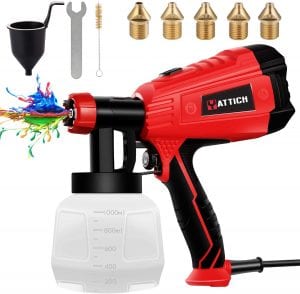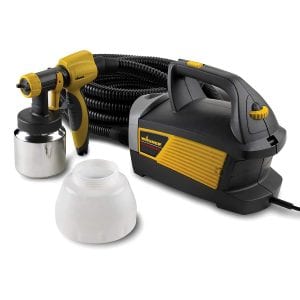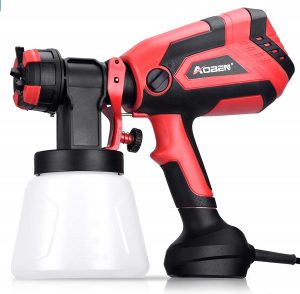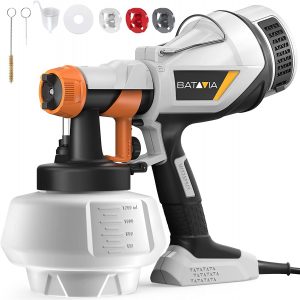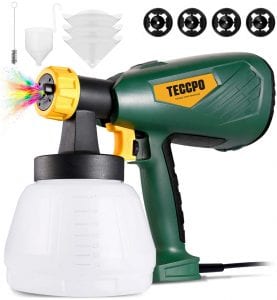The Best Paint Sprayer
We looked at the top 16 Paint Sprayers and dug through the reviews from 60 of the most popular review sites including and more. The result is a ranking of the best Paint Sprayers.
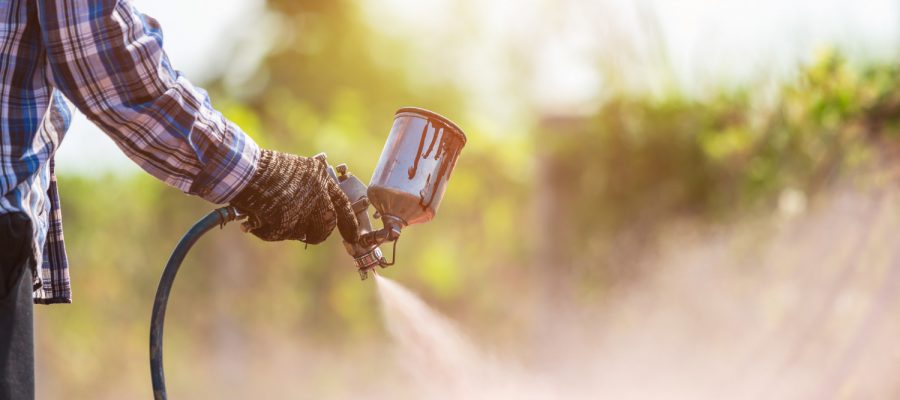
Our Review Process
Don't Waste Your Money is focused on helping you make the best purchasing decision. Our team of experts spends hundreds of hours analyzing, testing, and researching products so you don't have to. Learn more.
Our Picks For The Top Paint Sprayers
Whether you're tackling a smaller job, such as a set of chairs, or a larger job, like a car, this paint sprayer has you covered. It comes with three separate spray patterns and five differently-sized nozzles. The nozzles are made of copper, which prevents clogs and allows for higher pressure when needed.
Long Power CordAll of the parts on this paint sprayer are detachable for easy cleaning.
With a powerful turbine, this paint sprayer can accommodate paints in a variety of thickness. It's just as versatile in performance, with multiple spray nozzles and a Flex Air Hose to give extra reach when needed. You can remove each part of the sprayer for easy cleaning.
Lots of OptionsCustomization is key with this sprayer, which allows users to choose paint thickness and whether they want to paint vertically, horizontally or round.
Make quick work of your indoor and outdoor projects with this paint sprayer. It comes with four different nozzles and the ability to switch between three spray patterns. The large 1,000-milliliter paint container is also a plus, as you won't have to stop and refill the tank as often.
Multiple ColorsYou'll find this paint sprayer comes in a choice of a bold blue or a bright red.
With this paint sprayer, you'll be able to paint a fence, color your walls or brighten up your kitchen cabinets. The gun is comfortable to hold and designed to be user-friendly for beginners. The paint tank has a large 1,200-milliliter capacity and the machine comes with four nozzles and three spray patterns.
Versatile OptionThis paint sprayer can be used with a variety of paint types, including stain, lacquer and latex paint.
The horizontal, circular and vertical spray patterns on this paint sprayer allow you to paint everything from fences to siding to ceilings. You'll get several accessories with this model, including four nozzles, a cleaning needle and a cleaning brush. The unit even comes with a paint strainer to filter out any particles in the paint.
Three Spray PatternsIn addition to applying paint, this paint sprayer can be used to dispense a disinfectant.
Buying Guide
Anyone who has spent an afternoon or longer applying layer after layer of paint to a room knows the value of a paint sprayer, even if they’ve never used one before. Why brush when you can spray a nice, even coat with a wave of your hand? Why indeed — but take a little of that time you’re going to save on the job and do your research. Not every sprayer is ideal for every job.
Essentially, there are three different types of paint sprayers. The classic version is an air sprayer, which typically uses an air compressor to push paint out through a nozzle. While easy to use and inexpensive, it’s a tradeoff in terms of performance. As you might expect, the high pressure behind the paint results in less accuracy and more paint used. Special nozzles can mitigate this somewhat, but in general, these sprayers are fine for large indoor areas and less so for detail work.
A more versatile option is the HVLP, or “high volume, low pressure” sprayer. While they use air to push paint out through a nozzle at a gentler rate, they also typically employ a turbine of some kind and a special tip to atomize the paint as it comes out. This results in smaller particles of paint that spatter less. That means more accuracy and no air compressor to attach. With the ability to handle most any interior project and even some exterior jobs, the HVLP sprayer is becoming a more popular mid-range choice.
For big exteriors, you’ll find most professionals using some form of airless sprayer. Electric or gas powered, these sprayers typically use a hydraulic pump to draw paint out through the nozzle at high pressure in an even coat. Most airless sprayers siphon the paint directly out of the bucket. With their high horsepower, they can handle most any type of paint without having to thin it first. They also work on basically any surface, including interiors (even ceilings), exterior walls, fences, decks — you name it.
Clearly, the kind of surface that needs painting determines the type of sprayer you’ll want. From there, keep in mind that you’ll generally need some kind of attachments or even paint thinner, depending on the device. The pattern that paint comes out in will be either in a round shape or horizontal/vertical lines, depending on which way you twist the nozzle. Special tips can change the spray type to suit your need.
Finally, make sure you test your sprayer with a bit of water before you get to work. It’s helpful to know what kind of pressure you’re dealing with so you can adjust the flow and avoid messes before they start.
Why we recommend these paint sprayers?
Products Considered
Products Analyzed
Expert Reviews Included
User Opinions Analyzed
The Best Bang For Your Buck
TECCPO Ultra-Strong 3-Setting Paint Sprayer
Key Takeawy
The horizontal, circular and vertical spray patterns on this paint sprayer allow you to paint everything from fences to siding to ceilings. You'll get several accessories with this model, including four nozzles, a cleaning needle and a cleaning brush. The unit even comes with a paint strainer to filter out any particles in the paint.
What to Look For
- For indoor jobs, you’re typically going to be fine with a compressed air or HVLP sprayer. Use a compressed air sprayer for large walls and HVLP for detail work and a more even coat. For bigger outdoor surfaces, an airless sprayer can be a huge time-saver. They’re also good for lacquers or varnish, though cleanup of the sprayer can be tougher afterward.
- In general, thicker paints may not work well with air and HVLP sprayers, while airless sprayers can usually handle the thicker stuff. Check product specs before you buy, or ask the hardware store employee for tips.
- When it comes to nozzles, most models come with an assortment. Make sure you match the tip to the job. A sprayer with a lot of horsepower is great for pushing out a faster, thicker coat, but bear in mind you’ll need a bigger tip to accommodate all that pressure. For detail work, a horizontal or vertical spray tip is typically your best bet, while round patterns can put out wider coverage for a larger area. Reversible tips can also help manage paint clogging. Just unscrew the nozzle, turn it around and blow the clog out the other end.
- Ask any veteran painter, and they’ll tell you cleanup is a big factor. It’s great saving all that time with a sprayer until you spend hours cleaning an inferior model afterward. Look for a sprayer that you can disassemble into component parts, such as the Wagner Spraytech. Preferably, those parts will be made of easy-washing materials, like brass or stainless steel. When cleaning, you can soak most lines in water and use a solvent, such as flushing fluid, for the filters and tips.
- Whether your job is indoor or outdoor, you’ll want to factor in sprayer capacity — especially for air sprayers, which can burn through plenty of paint in a short time. Most air or HVLP sprayers can hold 20-40 ounces at a time.
- Portability can also be a big concern, especially for outdoor work. While air or HVLP sprayers have a self-contained supply of paint, airless sprayers typically draw from the paint can itself. That also means you’re limited to where you can carry it. Check the hose and power cord length on your airless sprayer, both of which can typically be upgraded if you need a longer one.
- As with any paint job, you’ll want to tape and cover carpets and other extraneous surfaces. That goes double with paint sprayers, even the relatively accurate HVLP variety. Again, you’ll want to test your sprayer ahead of time with a bit of water to get a feel for the pressure and spread.
- Speaking of spread, protect yourself along with those covered surfaces. Atomized paint can be toxic to breathe in, so wear eye protection and a filter mask before getting to work.
You May Also Enjoy Our Other Reviews
- Robotic Vacuum
- Cordless Vacuums
- Air Mattress
- Drone
- Electric Razor
- Convertible Car Seat
- Infant Car Seat
- Dry Dog Food
- Carpet Cleaners
- Air Fryers
- Laptops
- Home Printers
- Wireless Router
- Streaming Device
- Electric Pressure Cooker
- Chromebook
- Television
- Digital Camera To Capture Special Moments On The Fly
- Smartwatch
- Upright Vacuum


